Dig Timeline
Catch up on all the action from site, as it happens
- Overview
- Key Dates
- Diary
- Photos
- Videos
Sep 13 2020 - 1:00 PM
The furnace area… in 3D!
Our main goal this season is to understand the furnace area, and we’re making great progress already. We can already see that it’s much larger than initially thought, with more pits and spreads of metalworking dotted around.
But things are starting to get really interesting: on one side of the big circular feature, there’s a squareish stone stucture, with a skeleton inside. We’re currently trying to figure out if it’s a flue or stokehole into which a burial has later been placed, or whether it’s a very substantial stone-lined grave that has been dug into the furnace decades or centuries after it went out of use.
Sep 27 2021 - 1:00 PM
The 2021 season comes to an end
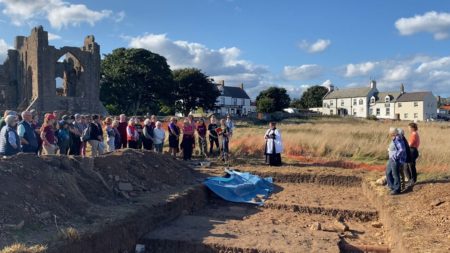
Today the team have been backfilling the trenches and packing everything away. We’re not ready to say goodbye yet, but knowing we’ll come back next year makes us feel better about leaving this beautiful island.
Yesterday, we had a touching ceremony to reinter some of the human remains that had been lifted this year. Thank you to everyone who attended and joined us in paying our respects to Lindisfarne’s previous residents.
And, finally, a huge thank you to everyone who has crowdfunded our dig this year, both digital crowdfunders and our Venturers! Without you all this wouldn’t be possible.
See you next year!
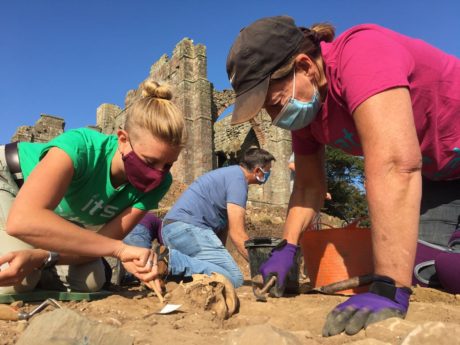
Oct 1 2020 - 11:00 AM
Site Diary: Our Best Discoveries from Lindisfarne (2020)
An early medieval smithy, a handful of coins, and a burial with signs of a fatal headwound are among some of the most notable discoveries from this season’s community-powered excavation on Lindisfarne. We’re now…
Sep 15 2019 - 10:00 PM
Photos!
Scroll through our album of photos from the last two weeks at Lindisfarne. Can you spot yourself? If you’ve got some you’d like to share, drop them into the Facebook Group Chat.
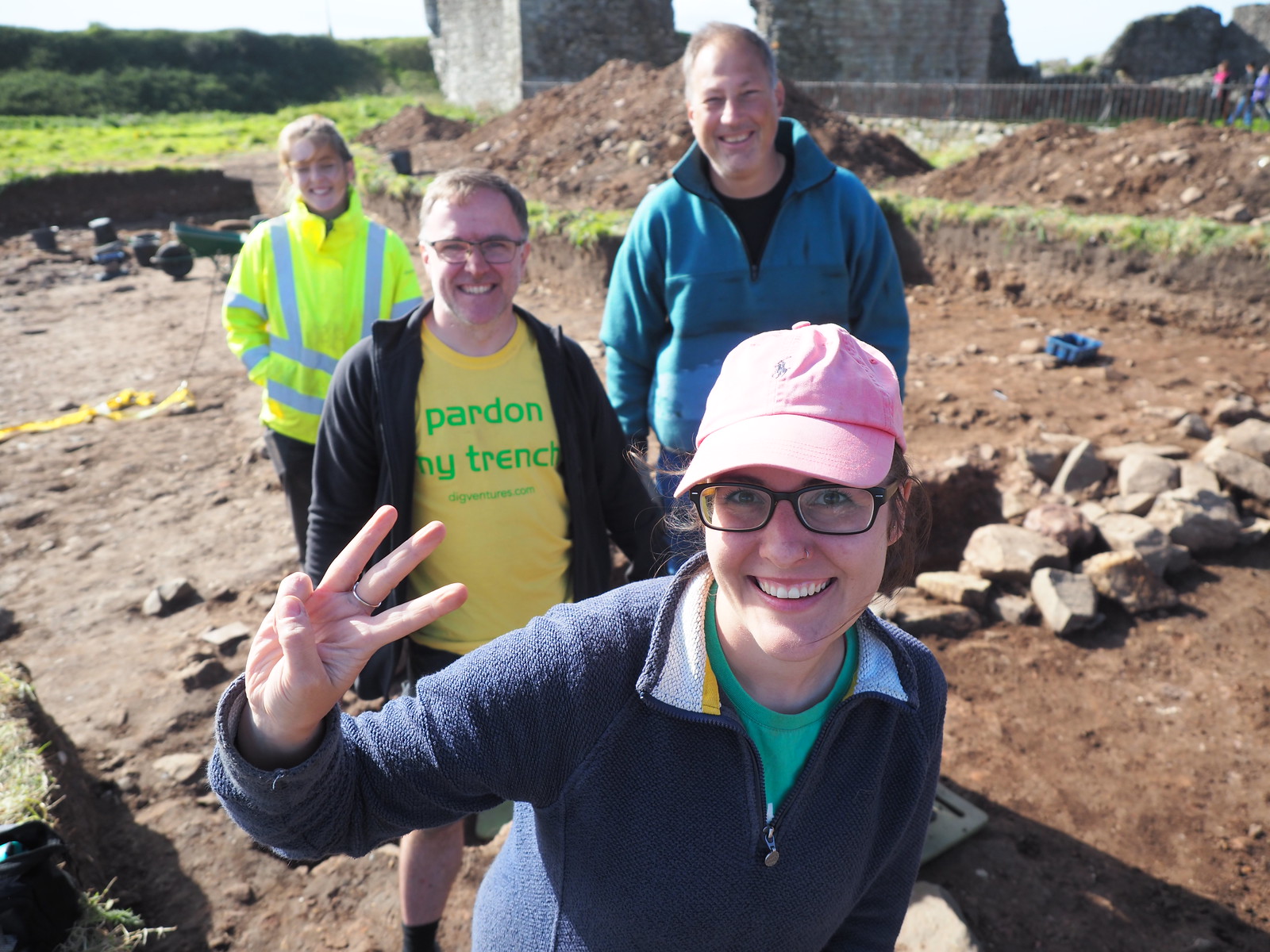
Sep 21 2020 - 1:00 PM
Before and after the Viking raids (animation)
We made a special animation to show you what the island looked like before and after the Viking raids, and bring to life some of the discoveries we’ve made over the last few years. Enjoy!
Archaeologists Return!
DigVentures will lead a two-week excavation in June 2016, to investigate the geophysics results and establish whether they are indeed the remains of Oswald’s Anglo-Saxon monastery.
Geophysical Survey
Archaeologists carried out a village-wide geophysical survey, and discovered a number of areas containing remains (including some near the Norman Priory), which may relate to the original Anglo-Saxon monastery.
Tantalising Hints
A series of small excavations took place across Lindisfarne ahead of construction work, providing tantalising hints of Anglo-Saxon and other early medieval features across the village.
Major Archaeological Work
Archaeologists from Leicester and Lampeter Universities investigated the north side of the island, and found a range of sites including flint scatters from Mesolithic hunter-gatherers, and an important early medieval farmstead at Green Shiel.
Brian Hope-Taylor Arrives
Leading archaeologist Brian Hope-Taylor started work on Lindisfarne having previously excavated the major Anglo-Saxon palace nearby at Yeavering. On Lindisfarne, he excavated a series of trenches along The Heugh, and several trenches in a field to the west of St Mary’s Church. Only recently have his notes and plans become accessible.
Clearing the Norman Priory
The overgrown ruins of the later Norman Priory were cleared in order to present them to the public. A large number of archaeological finds were recovered; amongst them were fragments of Anglo-Saxon sculpture, suggesting that the original monastery lies somewhere near the later priory.
Rediscovering the Anglo-Saxons
Historians had always known about the Anglo-Saxon history of Lindisfarne, but it wasn’t until in the late 19th century that the first remains from this period were found. A small collection of Anglo-Saxon stone carvings was placed in the parish church.
Romantic Ruins
Life for the villagers on Lindisfarne in the 18th century was dominated by fishing and farming, with the lime industry becoming increasingly important in the 19th century. The picturesque ruins of the Norman Priory became a common subject for Romantic artists.
Cannons and Castles
In the 17th century, Lindisfarne held an important strategic role on an unstable border with Scotland. Lindisfarne Castle was built, and together with Osbourne’s Fort, which lies on the east end of The Heugh, it protected the important harbour on the island.
Dissolution and Defence
In the mid-16th century Henry VIII abolished all English monasteries, including Lindisfarne Priory, and it was soon turned into a fortified military base. Although not all the planned defences were built, a naval supply base was constructed to the north at the site known as The Palace.
Scottish Wars
Lindisfarne stood on a troubled frontier. North Northumberland was the site of many battles between England and Scotland, with the Scottish kings regularly raiding the area. As a result, the monks took the unusual decision to provide the monastery with defences.
Refounding the Monastery
After the Norman conquest, and its destruction at the hands of Viking and Scottish raiders, the monastery at Lindisfarne was re-built, with the new monastic church and buildings re-constructed to look like those at Durham. The ruins of these structures can still be seen on Lindisfarne.
Raids
The Anglo-Saxon monastery on the island faced the wrath of raiders, both from Viking lands and from the increasingly powerful Scottish kingdoms to the north. Even then, it’s clear that some monks remained on Lindisfarne continuing to maintain the church and monastery.
Leaving the Island?
The most important monks gathered together the holy relics from the monastery and left the island, seeking shelter from the Viking raids. After spending just over a century moving around Northern England, the monks finally found a new home in Durham in AD995, where the relics still lie.
Thunder from the North
Lindisfarne was one of the first places in England to suffer a major attack by Vikings. Its wealth and exposed location on the North Sea coast made it a tempting target to Scandinavian raiders.
A Golden Age
During its Golden Age, Lindisfarne attracted many pilgrims to the shrine of St Cuthbert and was supported by the mighty kings of Northumbria, one of the most powerful kingdoms in Anglo-Saxon England. Under their patronage the monastery acquired large estates in Northumberland and beyond.
The Lindisfarne Gospels
Famous for its intricate designs and finely crafted decorations, this gospel book was probably created as part of the process of building the cult of St Cuthbert, a prominent monk at Lindisfarne. The Lindisfarne Gospels are one of the highlights of early medieval art.
Making a Saint
In this year the body of St Cuthbert was removed from his grave in the main church and placed in a new shrine. This marked the beginning of a new cult centred on his relics which attracted many pilgrims to Lindisfarne.
Age of Cuthbert
Cuthbert was born in the Scottish borders and first became a monk at Melrose, before becoming head of the monastery on Lindisfarne in AD655. Although he eventually became a Bishop, he spent his final years as a hermit on the island of Inner Farne just across the sea from Lindisfarne.
Founding the Monastery
Oswald, the new king of Northumbria, founded the monastery on Lindisfarne with the help of Aidan, a monk from the Scottish monastery of Iona. This introduced a distinctly Scottish and Irish strain of Christianity to Northumbria.
Siege!
The early medieval text, Historia Brittonum states that the British warrior king Urien of Rheged besieged the Angles and defeated them on Lindisfarne.
Beyond the Roman World
Lindisfarne lies nearly 50 miles north of Hadrian’s Wall and was only briefly part of the Roman Empire. Only a few fragments of Roman pottery have been found on the island, although the Roman road known as the Devil’s Causeway ran nearby on the mainland heading towards Scotland.
Iron Age Warriors and Farmers
The mainland opposite Lindisfarne was heavily occupied during the Iron Age; cropmarks have shown traces of defended farmsteads and hillforts. There is limited evidence for activity on Lindisfarne, although a possible enclosure was found in a geophysical survey in 2012.
Harvesting the Shore
Small bands of prehistoric hunters and gatherers use the island for its many sources of food, including fish, wild birds and seals. Archaeologists have found their flint tools on the north side of Lindisfarne.

Oct 1 2020 - 11:00 AM
Site Diary: Our Best Discoveries from Lindisfarne (2020)
An early medieval smithy, a handful of coins, and a burial with signs of a fatal headwound are among some of the most notable discoveries from this season’s community-powered excavation on Lindisfarne. We’re now…
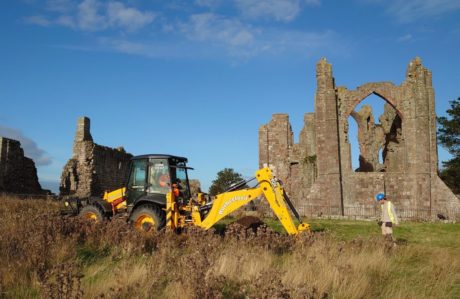
Sep 5 2020 - 11:00 AM
Site Diary: What we’re hoping to find in 2020
We’re back on Lindisfarne, getting ready to start our fifth season of excavation on the island so that we can continue to investigate the early medieval community who lived here before, during and after…
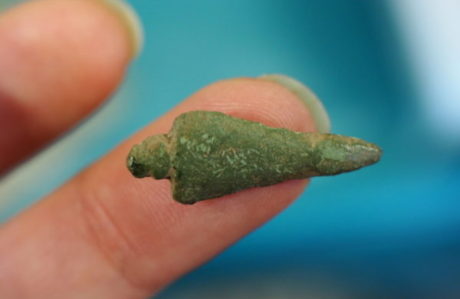
Sep 15 2019 - 10:30 PM
Site Diary: Our Best Discoveries On Lindisfarne So Far (2019)
This year, we’ve had so many great discoveries at Lindisfarne that we couldn’t fit them all in one video! It’s the end of our fourth crowdfunded dig at Lindisfarne and this year, we’ve made…
Sep 15 2019 - 10:00 PM
Photos!
Scroll through our album of photos from the last two weeks at Lindisfarne. Can you spot yourself? If you’ve got some you’d like to share, drop them into the Facebook Group Chat.

Sep 21 2020 - 1:00 PM
Before and after the Viking raids (animation)
We made a special animation to show you what the island looked like before and after the Viking raids, and bring to life some of the discoveries we’ve made over the last few years. Enjoy!
Sep 16 2020 - 3:00 PM
👣 It’s time for a Virtual Tour
Want to see what’s happening in the trenches? We’ve got some breaking news! Come and watch our Virtual Tour to find out what we’ve discovered…
Feb 7 2020 - 10:30 AM
🔎 The expert’s view
Who do you call when you find something as astonishingly rare and unique as the king from a tafl set? Mark Hall!
Mark is a leading specialist in Roman and early medieval games, and Collections Officer at Perth Museum & Art Gallery.
“It is extraordinary to find a glass tafl gaming piece like this in such perfect condition. They’re as rare as hen’s teeth,” he told us when he came to inspect it!

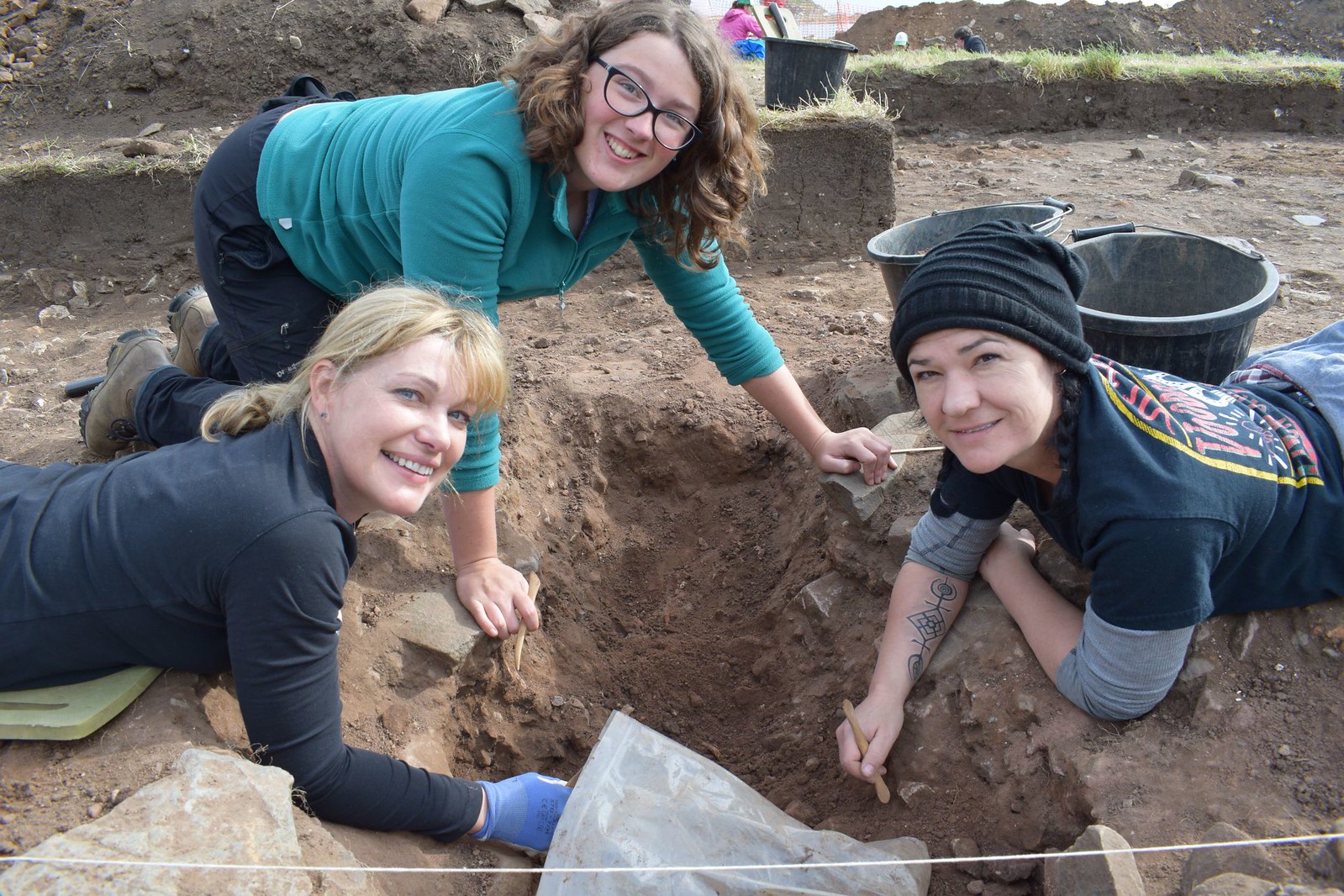
Jun 25 2016 - 2:28 PM
Jun 25 2016 - 1:14 PM
Jun 25 2016 - 11:11 AM